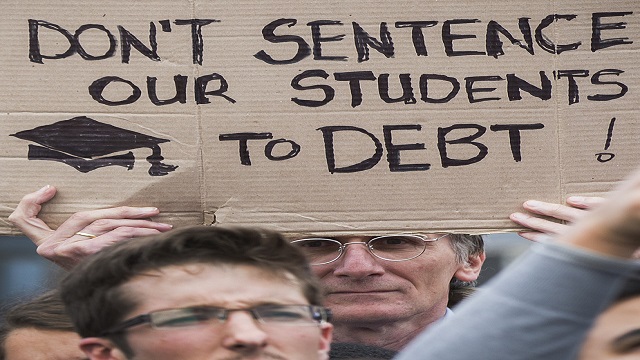
In mid-December 2016, the South African Minister of Higher Education and Training released the report of a ministerial task team set up to investigate student funding for those who can’t afford higher education.
The timing of the report’s release coincided with the start of the annual holiday season which precluded public scrutiny and engagement. This was a missed opportunity. The report is a welcome contribution to the debate on student funding in South Africa.
Its main recommendations provide a realistic framework for rethinking approaches to student funding. These include grants for very poor students and a combination of grants (progressively reduced as household income increases) and loans for the poor and “missing middle” – students whose parental income is above the cut-off point to qualify for loans from the National Student Financial Aid Scheme (NSFAS) but insufficient to meet the full costs of higher education. This approach reduces the repayment burden.
The report also recommends the mobilisation of private sector funds through various tax incentives. And it suggests that loan recovery mechanisms could be improved through direct deductions by the South African Revenue Service (SARS).
But there’s one key flaw in the report. It recommends that a new agency, the Ikusasa Student Financial Aid Programme, be established to replace the NSFAS. It was established in 1999 to ensure that funding is not a barrier to access to higher education for poor students. It has successfully discharged this mandate and supported just more than one million students in the past 18 years.
The report presents a jaundiced view of an important organisation that has opened the doors of higher education to many who would otherwise have been left out.
Myths and realities
One of the report’s recommendations is that Ikusasa should establish a special purpose vehicle run by the private sector to manage student funding on the government’s behalf.
It argues that this is necessary to counter the private sector’s apparent lack of confidence in the NSFAS, which is ascribed to the scheme having weak accountability structures and inefficient processes, especially its poor loan recovery record. The NSFAS has as a result apparently lost “most of the funding it used to receive from the private sector”.
There’s no evidence provided to support this assertion. This is because there has been no private sector funding of the NSFAS other than its administration of bursaries on behalf of one of the major banks.
The NSFAS was also remarkably successful in recovering loans between 1997 and 2008, increasing from R30 million to R636m. After that the amount decreased: only R248m was recovered in 2014, as against projections of R1 711m. This was because of the promulgation of the National Credit Act in 2005.
This legislation made it illegal to recover loans from debtors through automatic deductions by employers, which was provided for in the NSFAS Act. This has severely impacted on the funding available to the NSFAS.
The role of funding agencies
The report is also on weak ground in its attempt to deal with broader skills and educational issues.
It proposes that funding should prioritise professional and vocational programmes in scarce skills and high demand occupations to “grow the economy”. This refers to the need to grow enrolments in science, engineering and technology.
The scarce skills focus would adversely impact on poor students’ access to higher education. They are the main recipients of low quality schooling, especially in gateway subjects like maths and science which are essential for access to the programmes in question.
The report also proposes that Ikusasa should develop a “wrap-around” student support programme. Social, life skills and academic support to improve throughput and graduation rates would be provided using external service providers. This betrays a lack of understanding of the challenges of teaching and learning in higher education. The fact that such support has been successfully provided on a small scale by NGOs and private sector bursary programmes does not necessarily mean it can be taken to scale.
What is needed is systemic intervention to address the knowledge and skills gap between school and university. This requires restructuring the curriculum and qualifications structure in higher education, as has been proposed by the Council on Higher Education. This is the joint responsibility of government and higher education institutions – not funding agencies.
A crucial body
The report’s uncritical focus on enhancing the role of the private sector in student funding is cause for concern. It ignores the fact that the private sector is risk averse. In the absence of collateral in the form of government guarantees, it’s unlikely to come to the party. And at any rate, it projects that direct private sector investment will comprise of no more than one-fifth of the total funding required to implement the proposed model.
The private sector has a role to play in student funding. But this can best be done through an expanded NSFAS, with a separate and dedicated sub-structure established to deal with private sector contributions and investments.
There’s no denying that administrative and governance challenges have had an impact on the NSFAS’ efficiency and effectiveness. This is largely due to the rapid growth of the funds it administers without a concomitant development of administrative systems. There has been progress in addressing these challenges and no doubt more needs to be done. But its real challenge is too little funding to meet demand. The private sector can contribute to alleviating this.
However, ultimately it’s the government’s responsibility to ensure that student funding is adequate to meet demand.
The NSFAS, despite its challenges, has played a critical role in opening the doors of higher education to the poor. It has been one of success stories of the post-1994 commitment to social justice and the redress of past inequalities. The NSFAS cannot be wished away by the whims of a task team which seems have little or no understanding of the social and political context that gave rise to it.
